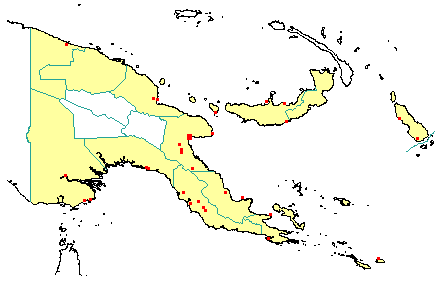
in PNGplants database
PNGTreesKey – Pterocarpus indicus Willd. |
Barry Conn (NSW) & Kipiro Damas (LAE).
Guide to trees of Papua New Guinea
Copyright held by the authors, National Herbarium of New South Wales, and Papua New Guinea National Herbarium
Species Plantarum, edition 4 Vol. 3: 904 (1802)
Other Literature: B. Verdcourt, A Manual of New Guinea Legumes 298-299 (1979) Fig. 66.
Family: Fabaceae
Dicotyledon
Timber Group: Major exportable hardwood Tradename: New Guinea Rosewood
Field Characters: Emergent tree (up to 40 m high), Large canopy tree (10-30 m high), or Small sub-canopy tree; Bole cylindrical (up to 250 cm diam.); often crooked or straight (bole up to 17 m long, rarely to 24 m); buttresses buttresses present (usually short, sometimes up to 4 m high); spines spines absent; aerial roots aerial roots absent; stilt roots stilt roots absent; Bark yellow, brownish grey, or greenish brown, slightly rough, scaly or flaky (in thin plates) or scattered pustular, lenticels rounded/swelling; less than 25 mm thick, 5.0-6.0; bark blaze consisting of one layer; faintly to non-aromatic; outer blaze white (straw- to cream-coloured) or slightly pink, markings absent; inner blaze white (straw- or cream-coloured) or slightly pink, markings absent; bark exudate (sap) present, dark red, flowing, colour not changing on exposure to air, sticky; terminal buds not enclosed by leaves.
Indumentum: Complex hairs absent; stinging hairs absent; mature twig indumentum (hairs) absent.
Leaves: Leaves spaced along branches, spiral (leaves occurring singly at a node and arranged spirally up the branchlet), compound (a leaf made up from two or more leaflets); petiole present, not winged, attached to base of leaf blade, not swollen; leaves pinnate (unbranched with more than three leaflets); petiolule not swollen; rachis present, absent, absent; leaves with a terminal leaflet (the number of leaflets odd - imparipinnate), broadest below middle, 3.0-14.0 cm, 2.0-6.5 cm, leaflets alternate, symmetric, terminal developing leaflet buds absent; venation pinnate, secondary veins open, prominent, intramarginal veins absent; leaves lower surface pale green, upper surface green, indumentum (hairs) absent or present (on lower surface), indumentum (hairs) dense; absent; domatia absent; stipules present, free, laterally placed, not encircling the twig, leafy, not fringed, large, not persistent.
Flowers: Inflorescence terminal or axillary, flowers on an unbranched axis, cones absent; flowers bisexual, stalked, flowers with one plane of symmetry, 10.0 (c.) mm long, diameter small (up to10 mm diam.); perianth present, with distinct sepals and petals whorls, inner perianth yellow or yellowish orange; 5, free; stamens 10, present, joined, free of the perianth; ovary superior, carpels joined (when more than one), locules 1; styles solitary.
Fruits: Infrutescence arranged on unbranched axis, fruit 65.0-70.0 mm long, brown (flattened and round), not spiny, non-fleshy, simple, usually indehiscent or dehiscent, legume; seeds 1-4, much more than 10 mm long (up to c. 30 mm long), winged (fruit with a thickened central seed-bearing part and a surrounding stiff membranous wing), broad (as wide as long), seed more than 10 mm diam. (flattened, c. 40 mm wide).
Distribution: West Sepik, East Sepik, Madang, Morobe, Western, Gulf, Central, Northern, Milne Bay, Papuan Islands, New Britain & Bougainville.
 | Botanical records in PNGplants database |
Notes: Notes This species is classified in Fabaceae subfamily Faboideae.